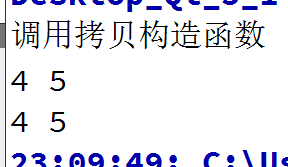《c++程序设计语言(第四版)》3.3.2章节、17.5.2章节
1、移动构造函数是构造函数的一种,用移动其他对象的资源的方式构造对象。
#define debug qDebug()<<
struct ceshi
{
int frist;
int second;
ceshi(int one = 0,int two = 0):frist{one},second{two}
{
}
ceshi(ceshi && c):frist{c.frist},second{c.second}
{
debug "调用移动构造";
c.frist = -1;
c.second = -1;
}
};
int main(int argc, char *argv[])
{
ceshi a(4,5);
ceshi b = std::move(a);
debug a.frist << a.second << &a;
debug b.frist << b.second << &b;
}
2、std::move()
此函数的作用只是获取右值引用,虽然函数名称叫做move,但没有移动任何东西。
ceshi b = std::move(a);这么写就会调用移动构造函数,将获取的右值引用作为参数传递。
3、如果类中没有定义移动构造函数,这么写会调用拷贝构造函数:
#define debug qDebug()<<
struct ceshi
{
int frist;
int second;
ceshi(int one = 0,int two = 0):frist{one},second{two}
{
}
ceshi(const ceshi & c)
{
this->frist = c.frist;
this->second = c.second;
debug "调用拷贝构造函数";
}
};
int main(int argc, char *argv[])
{
ceshi a(4,5);
ceshi b = std::move(a);
debug a.frist << a.second;
debug b.frist << b.second;
}